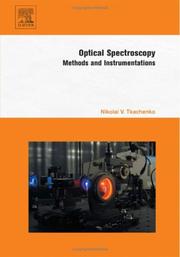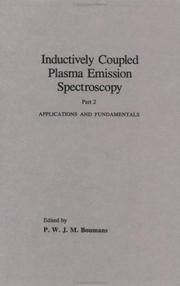| Listing 1 - 10 of 37 | << page >> |
Sort by
|
Book
ISBN: 1633212777 9781633212770 9781633211971 Year: 2014 Publisher: New York
Abstract | Keywords | Export | Availability | Bookmark
 Loading...
Loading...Choose an application
- Reference Manager
- EndNote
- RefWorks (Direct export to RefWorks)
Optical spectroscopy. --- Spectroscopy, Optical --- Visible spectroscopy --- Spectrum analysis
Book
ISBN: 1316795632 131680562X Year: 2021 Publisher: Cambridge : Cambridge University Press,
Abstract | Keywords | Export | Availability | Bookmark
 Loading...
Loading...Choose an application
- Reference Manager
- EndNote
- RefWorks (Direct export to RefWorks)
An invaluable text for the teaching, design, and development of gas sensor technology. This excellent resource synthesizes the fundamental principles of spectroscopy, laser physics, and photonics technology and engineering to enable the reader to fully understand the key issues and apply them in the design of optical gas absorption sensors. It provides a straightforward introduction to low-cost and highly versatile near-IR systems, as well as an extensive review of mid-IR systems. Fibre laser systems for spectroscopy are also examined in detail, especially the emerging technique of frequency comb spectroscopy. Featuring many examples of real-world application and performance, as well as MATLAB computer programs for modeling and simulation, this exceptional work is ideal for postgraduate students, researchers, and professional engineers seeking to gain an in-depth understanding of the principles and applications of fibre-optic and laser-based gas sensors.
Laser spectroscopy. --- Optical spectroscopy. --- Spectroscopy, Optical --- Visible spectroscopy --- Spectrum analysis
Book
ISBN: 3036573836 3036573828 Year: 2023 Publisher: Basel, Switzerland : MDPI - Multidisciplinary Digital Publishing Institute,
Abstract | Keywords | Export | Availability | Bookmark
 Loading...
Loading...Choose an application
- Reference Manager
- EndNote
- RefWorks (Direct export to RefWorks)
This reprint is devoted to studying RE-doped bulk and nanocrystalline materials from a scientific point of view and to presenting their possible applications in any field. This reprint is intended to serve as a unique multidisciplinary forum covering all aspects of science, technology and applications of rare-earth-doped crystals, starting from the growth techniques with specific attention to the optical and spectroscopic properties of these materials and their applications.
Optical spectroscopy. --- Spectroscopy, Optical --- Visible spectroscopy --- Spectrum analysis
Book
ISBN: 0323480683 0323480675 9780323480680 9780323480673 Year: 2019 Publisher: Amsterdam, Netherlands : Elsevier,
Abstract | Keywords | Export | Availability | Bookmark
 Loading...
Loading...Choose an application
- Reference Manager
- EndNote
- RefWorks (Direct export to RefWorks)
Optical spectroscopy. --- Spectroscopic imaging. --- Diagnostic imaging --- Spectroscopy, Optical --- Visible spectroscopy --- Spectrum analysis
Book
Year: 1983 Publisher: London : McGraw-Hill,
Abstract | Keywords | Export | Availability | Bookmark
 Loading...
Loading...Choose an application
- Reference Manager
- EndNote
- RefWorks (Direct export to RefWorks)
Book
ISBN: 9781620818350 1620818353 9781620818008 1620818000 Year: 2012 Publisher: New York
Abstract | Keywords | Export | Availability | Bookmark
 Loading...
Loading...Choose an application
- Reference Manager
- EndNote
- RefWorks (Direct export to RefWorks)
Optical spectroscopy. --- Imaging systems. --- Radar --- Remote sensing --- Television --- Scanning systems --- Spectroscopy, Optical --- Visible spectroscopy --- Spectrum analysis --- Equipment and supplies

ISBN: 9780444521262 0444521267 0080461727 9780080461724 9786610621798 1280621796 Year: 2006 Publisher: Amsterdam ; Boston : Elsevier,
Abstract | Keywords | Export | Availability | Bookmark
 Loading...
Loading...Choose an application
- Reference Manager
- EndNote
- RefWorks (Direct export to RefWorks)
Optical Spectroscopy bridges a gap by providing a background on optics while focusing on spectroscopic methodologies, tools and instrumentations. The book introduces the most widely used steady-state and time-resolved spectroscopic techniques, makes comparisons between them, and provides the methodology for estimating the most important characteristics of the techniques such as sensitivity and time resolution. Recent developments in lasers, optics and electronics has had a significant impact on modern optical spectroscopic methods and instrumentations. Combining the newest l
Atomic physics --- Optical spectroscopy. --- Optical instruments --- Optics --- Physical instruments --- Spectroscopy, Optical --- Visible spectroscopy --- Spectrum analysis --- Methodology. --- Instruments
Book
ISBN: 0198559496 9780198559498 Year: 2010 Publisher: Oxford Oxford University Press
Abstract | Keywords | Export | Availability | Bookmark
 Loading...
Loading...Choose an application
- Reference Manager
- EndNote
- RefWorks (Direct export to RefWorks)
Inorganic compounds. --- Mass spectrometry. --- Spectroscopie --- Inorganic chemistry --- Esr spectroscopy --- Nmr spectroscopy --- Uv and visible spectroscopy --- Vibrational spectroscopy

ISBN: 0471096865 047185378X 9780471853787 9780471096863 Year: 1987 Volume: 90 Publisher: New York (N.Y.): Wiley,
Abstract | Keywords | Export | Availability | Bookmark
 Loading...
Loading...Choose an application
- Reference Manager
- EndNote
- RefWorks (Direct export to RefWorks)
Tandem Mass Spectrometry Edited by F. W. McLafferty More than 50 contributors, representing 32 of the world's leading research groups in mass spectrometry, examine the fundamentals, methods, instrumentation and applications of MS/MS, as well as promising new directions. The book describes the general types of MS/MS applications, primarily trace analysis in complex mixture, molecular structure elucidation, and gaseous ion reaction mechanisms; basic methods and theory, including the production and dissociation of characteristic ions; the principal types of instruments employed; special techniques; and applications of MS/MS in numerous fields. 506 pp. (0 471-86597-4) 1983 Molecular Luminescence Spectroscopy Methods and Applications, Part One Edited by Stephen G. Schulman Providing encyclopedic coverage, the author examines the applications of fluorescence, phosphorescence, and chemiluminescence spectra to the analysis of organic and inorganic compounds. The book features discussions of topics never presented in an analytical text, such as excited state optical activity and bioinorganic luminescence spectroscopy, and exhaustive reviews of fluorescence and phosphorescence of pharmaceuticals. Chapters on fluorescence detection in chromatography and luminescence immunoassay are the most up-to-date treatments available on these subjects. 826 pp. (0 471-86848-5) 1985 Auger Electron Spectroscopy M. Thompson, M. Baker, A. Christie, and J. Tyson After comparing AES with other techniques in the general field of electron spectroscopy, this book reviews the fundamentals and theories underlying the AES effect. The authors-experienced users of AES-offer an easy-to-follow summary of procedures along with generic descriptions of equipment components. The book also deals with a sequence of studies of gas phase spectra from rare gases to metals to molecules. Chemical aspects of the methods are discussed, followed by a particularly comprehensive description of AES with reference t
Book
ISBN: 3980333310 Year: 1993 Publisher: Giessen : Brühl Universitätsdruckerei,
Abstract | Keywords | Export | Availability | Bookmark
 Loading...
Loading...Choose an application
- Reference Manager
- EndNote
- RefWorks (Direct export to RefWorks)
543.423 --- analytische chemie (scheikunde) --- atoomabsorptiespectroscopie --- atoomemissiespectroscopie --- emissiespectroscopie --- ontwerpen --- spectroscopie --- Process control and dynamics --- Spectrochemical analysis, atomic emission --- Spectrometers --- Uv and visible spectroscopy
| Listing 1 - 10 of 37 | << page >> |
Sort by
|

 Search
Search Feedback
Feedback About UniCat
About UniCat  Help
Help News
News